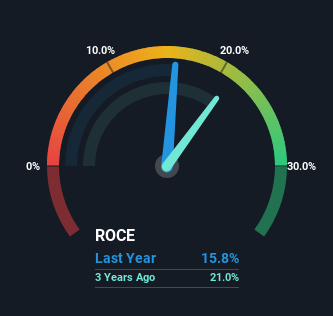Shiny Chemical Industrial (TWSE:1773) Might Be Having Difficulty Using Its Capital Effectively

If you're looking for a multi-bagger, there's a few things to keep an eye out for. Typically, we'll want to notice a trend of growing return on capital employed (ROCE) and alongside that, an expanding base of capital employed. This shows us that it's a compounding machine, able to continually reinvest its earnings back into the business and generate higher returns. Although, when we looked at Shiny Chemical Industrial (TWSE:1773), it didn't seem to tick all of these boxes.
Understanding Return On Capital Employed (ROCE)
For those that aren't sure what ROCE is, it measures the amount of pre-tax profits a company can generate from the capital employed in its business. To calculate this metric for Shiny Chemical Industrial, this is the formula:
Return on Capital Employed = Earnings Before Interest and Tax (EBIT) ÷ (Total Assets - Current Liabilities)
0.16 = NT$1.8b ÷ (NT$14b - NT$2.8b) (Based on the trailing twelve months to December 2023).
So, Shiny Chemical Industrial has an ROCE of 16%. On its own, that's a standard return, however it's much better than the 5.0% generated by the Chemicals industry.
Check out our latest analysis for Shiny Chemical Industrial

Historical performance is a great place to start when researching a stock so above you can see the gauge for Shiny Chemical Industrial's ROCE against it's prior returns. If you'd like to look at how Shiny Chemical Industrial has performed in the past in other metrics, you can view this free graph of Shiny Chemical Industrial's past earnings, revenue and cash flow.
What Can We Tell From Shiny Chemical Industrial's ROCE Trend?
When we looked at the ROCE trend at Shiny Chemical Industrial, we didn't gain much confidence. Over the last five years, returns on capital have decreased to 16% from 21% five years ago. Given the business is employing more capital while revenue has slipped, this is a bit concerning. This could mean that the business is losing its competitive advantage or market share, because while more money is being put into ventures, it's actually producing a lower return - "less bang for their buck" per se.
The Key Takeaway
In summary, we're somewhat concerned by Shiny Chemical Industrial's diminishing returns on increasing amounts of capital. Yet despite these poor fundamentals, the stock has gained a huge 253% over the last five years, so investors appear very optimistic. Regardless, we don't feel too comfortable with the fundamentals so we'd be steering clear of this stock for now.
On a final note, we've found 1 warning sign for Shiny Chemical Industrial that we think you should be aware of.
While Shiny Chemical Industrial isn't earning the highest return, check out this free list of companies that are earning high returns on equity with solid balance sheets.
New: Manage All Your Stock Portfolios in One Place
We've created the ultimate portfolio companion for stock investors, and it's free.
• Connect an unlimited number of Portfolios and see your total in one currency
• Be alerted to new Warning Signs or Risks via email or mobile
• Track the Fair Value of your stocks
Have feedback on this article? Concerned about the content? Get in touch with us directly. Alternatively, email editorial-team (at) simplywallst.com.
This article by Simply Wall St is general in nature. We provide commentary based on historical data and analyst forecasts only using an unbiased methodology and our articles are not intended to be financial advice. It does not constitute a recommendation to buy or sell any stock, and does not take account of your objectives, or your financial situation. We aim to bring you long-term focused analysis driven by fundamental data. Note that our analysis may not factor in the latest price-sensitive company announcements or qualitative material. Simply Wall St has no position in any stocks mentioned.
About TWSE:1773
Shiny Chemical Industrial
Engages in the manufacturing, processing, and trading of chemical solvents in Taiwan.
Solid track record with excellent balance sheet.
Market Insights
Community Narratives




